This year was historic for space research and exploration, and we have the photos to prove it.
In 2024, rare astronomical events captured the attention of sky watchers across the US, including a total solar eclipse, aurora that stretched as far south as Florida and striking meteor showers.
There were stunning accomplishments in the world of spaceflight, too.
SpaceX performed the first commercial spacewalk and caught a giant rocket with a pair of ‘chopstick’ arms, NASA completed the first flight of an aircraft on Mars, and International Space Station astronauts beamed amazing images back to Earth.
Telescopes in space and on Earth snapped some incredible shots too, capturing stars, other planets and even entire galaxies in unprecedented detail.
The James Webb Space Telescope (JWST), the Hubble Space Telescope (HST) and European Southern Observatory (ESO) are just a few of the highly-sophisticated imaging instruments that changed our understanding of the universe this year.
Below, DailyMail.com highlights some of 2024’s most jaw-dropping space photos.
Star-forming region NGC 604

JWST captured this near-infrared view of the star-forming region NGC 604, which sits in the Triangulum galaxy 2.7 million light-years from Earth
JWST‘s NIRcam instrument is a powerful near-infrared camera that can capture images of distant nebulae in astonishing detail.
This year, the telescope snapped this photo of the star-forming nebula known as NGC 604.
This enormous cloud of gas and dust is located 2.7 million light-years from Earth in the Triangulum galaxy.
Stretching almost 1,500 light-years across, NGC 604 is nearly 100 times larger than the Orion Nebula in our own galaxy.
NHC 604 contains more than 200 hot, massive young stars — significantly more than the Orion Nebula’s four.
This JWST image shows the nebula’s arms of gas and dust, which serve as a nursery for young, still-forming stars.
Starlink satellites captured by ISS astronaut
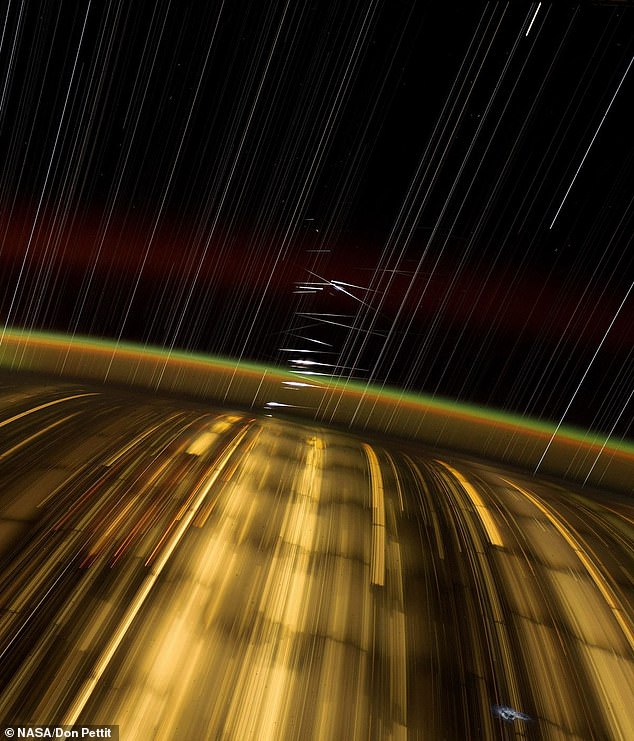
Don Pettit, a NASA astronaut aboard the ISS, shared this photo he took in November, which shows Starlink satellites streaking by
In November, NASA astronaut Don Pettit shared this image taken from the ISS, which shows Starlink satellites streaking by.
In a post on X, Pettit compared the satellites to ‘a miniature version of the monolith from ‘2001: A Space Odyssey’, where the large flat face of the monolith points towards earth and the solar panel protrudes outward like the fin on the back of a Dimetrodon.’
He described the image, saying: ‘Compared to the well-defined streaks from star trails, this time exposure shows wonky streaks flashing ISS.
‘These are Starlink satellites reflecting pre-dusk or pre-dawn sunlight off their solar panels. They are only seen from 5 to 18 degrees preceding or trailing the sun.
‘They create bright flashes, perhaps lasting for a few seconds each due to the orientation of their outward pointing solar panels.’
Pettit is well-known for his orbital astrophotography, which he creates from the unique vantage point of the ISS.
SpaceX’s ‘chopsticks’ rocket catch
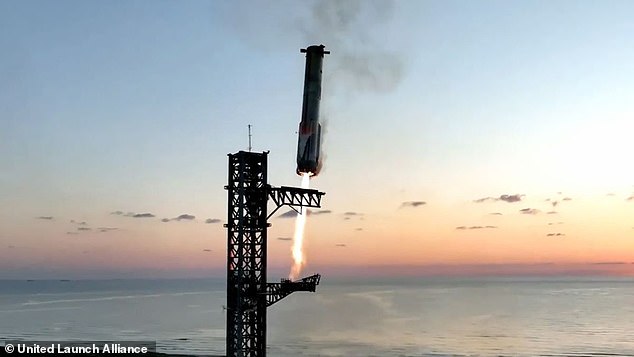
SpaceX achieved a historic spaceflight maneuver this year when the Mechazilla launch tower’s ‘chopstick’ arms caught the Super Heavy booster in mid-air, executing a bull’s eye landing
Elon Musk’s SpaceX made spaceflight history in October with the successful execution of a ‘chopstick’ maneuver.
It was the fifth time the spaceflight company launched its 400-foot-tall Starship rocket, but this launch was anything but routine.
In a world’s first, SpaceX aimed to return the rocket’s Super Heavy booster directly to its launch mount, snatching it out of mid-air with a pair of ‘chopstick’ arms attached to the launch tower.
Just seven minutes after liftoff, Super Heavy executed a bull’s eye landing, hovering near the ‘Mechazilla’ launch tower as the metal arms caught it.
The bold, historic maneuver marked a major achievement for SpaceX and the spaceflight industry at large.
‘Are you kidding me?’ SpaceX spokesperson Dan Huot added from the launch site following the event. ‘Even in this day and age, what we just saw — that looked like magic.’
Supermassive black hole Sagittarius A*
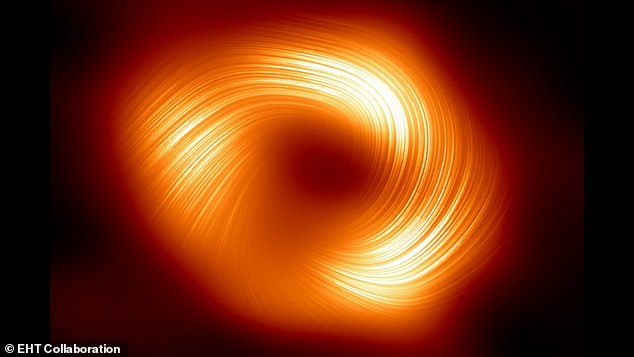
In 2024, astronomers captured the first image of the polarized light and magnetic fields that surround Sagittarius A*, the supermassive black hole at the center of the Milky Way
This year, astronomers captured the first image of the polarized light and magnetic fields that surround Sagittarius A*, the supermassive black hole that sits at the center of our Milky Way galaxy.
This image was made using the Event Horizon Telescope (EHT), a global network of radio telescopes that can observe a supermassive black hole’s event horizon, or the boundary where the velocity needed to escape exceeds the speed of light.
At just 26,000 light years from Earth, Sagittarius A* is one of very few black holes in the universe where astronomers can actually observe the flow of matter around it.
This historic image provides the first direct visual evidence of this supermassive black hole’s existence.
Although we cannot see the black hole itself — as it is completely dark — the glowing whirls of gas around it reveal a telltale signature: a dark central region (or ‘shadow’) surrounded by a bright ring-like structure.
The image therefore shows light bent by the black hole’s extreme gravity.
HP Tau: An infant star
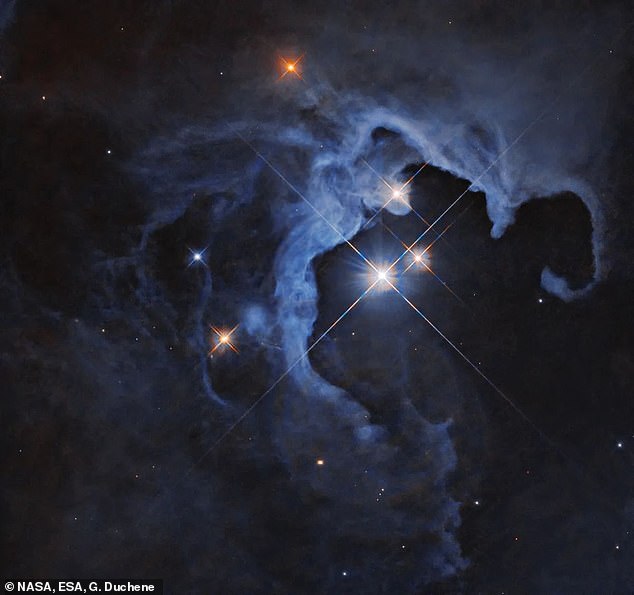
The Hubble Space Telescope captured this image of the infant star HP Tau this year, located 550 light-years from Earth
The Hubble Space Telescope snapped this stunning photo of the infant star HP Tau this year.
HP Tau is located roughly 550 light-years from Earth in the constellation Taurus. At just 10million years old, it is the youngest among its neighbors.
It can be seen at the top of a trio of stars captured in this Hubble image. These three stars reside within a hollow cavity in a huge cloud of gas and dust, ‘looking like a glittering cosmic geode,’ as NASA described it.
HP Tau is a T Tauri star, a type of young variable star that has not begun nuclear fusion yet, but will eventually evolve into a hydrogen-fueled star similar to our sun, according to NASA.
At 4.6 billion years old, our sun is far older than this infant.
First-ever commercial spacewalk

Tech billionaire and SpaceX astronaut Jared Isaacman made history when he emerged from the Polaris Dawn capsule to complete the first civilian spacewalk
In September, SpaceX’s Polaris Dawn crew made history by executing the first privately-funded spacewalk.
The achievement marked a major milestone for the commercial spaceflight industry, of which SpaceX is a key leader.
In this image, tech billionaire and Polaris Dawn mission commander Jared Isaacman can be seen emerging from the Crew Dragon capsule 434 miles above Earth’s surface as the sun rises over the eastern portion of the US.
He spent 12 minutes testing the mobility and functionality of SpaceX’s new extravehicular activity (EVA) suits, which had never been used in space before.
After Isaacman retreated back into the capsule, Polaris Dawn mission specialist Sarah Gillis, emerged and performed the same EVA test maneuvers.
‘Back at home, we all have a lot of work to do,’ said Isaacman as he looked down at our planet. ‘But from here, Earth sure looks like a perfect world.’
‘Doomed’ star Eta Carinae
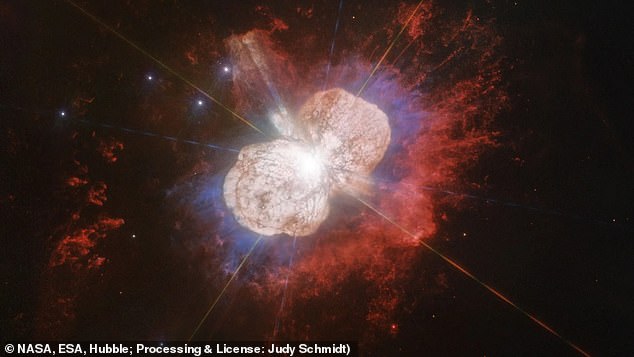
The Hubble Space Telescope captured this image of the unusual nebula that surrounds Eta Carinae, a star that is likely to explode at any time
This 2024 image captured by the Hubble Space Telescope brings out details in the unusual nebula that surrounds Eta Carinae, a star that may be about to explode.
Scientists aren’t sure exactly when this explosion could occur. According to NASA, it could be next year, or it could be a million years from now.
But when it does blow, it will likely cause a supernova — the biggest type of explosion known to man. Eta Carinae is about 100 times more massive than our sun.
Located 7,500 light-years away in the Keyhole nebula, its violent death would not impact Earth. But still, Hubble has been monitoring Eta Carinae for the last 25 years, waiting for it to explode.
In this image, two distinct lobes of the surrounding Homunculus Nebula encompass the hot central region, while some ‘strange’ radial streaks are visible in red extending toward the right, according to NASA.
Total solar eclipse
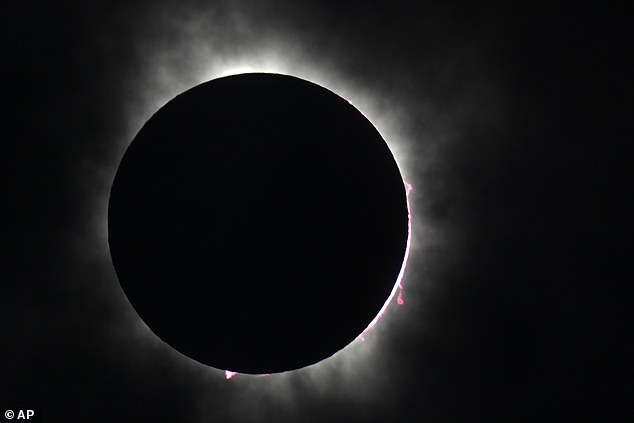
On April 8, skywatchers in 15 US states witnessed a total solar eclipse
On April 8, millions of Americans looked up at the sky in unison to witness a total solar eclipse.
All of North America experienced at least a partial solar eclipse. But 15 US states from Texas to Maine were in the 115-mile-wide path of totality, which also stretched through Canada and Mexico.
In this area, spectators experienced several minutes of near-total darkness as the sun disappeared behind the moon’s shadow.
Images of the eclipse were shared widely on social media, including this one which shows solar prominences erupting from the sun’s surface – the squiggly red lines that appear to be jetting out from the perimeter of the sun.
Solar prominences are eruptions of solar plasma, a hot gas made of electrically charged hydrogen and helium.
US sees far-reaching aurora
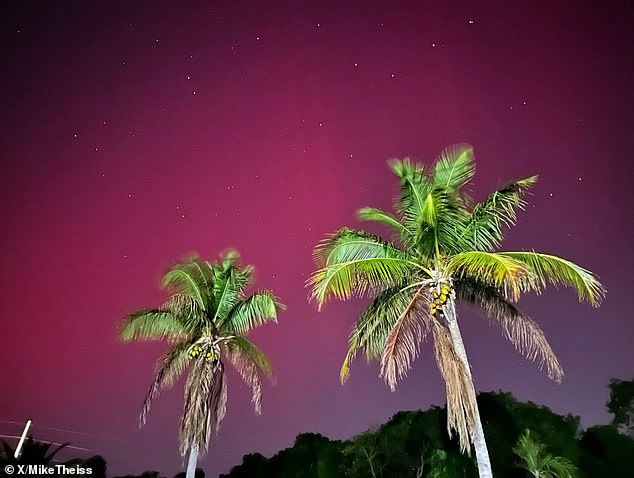
The aurora borealis is typically only seen at northern latitudes. But in October, this dazzling light display stretched as far south as Florida
In an extremely rare event, the aurora borealis — also known as the northern lights — stretched as far south as Key Largo, Florida in October.
The dazzling light display was triggered by a severe geomagnetic storm, or a major disturbance of Earth’s magnetosphere that occurs when an outburst of solar radiation impacts out planet.
This storm was a G5, the most severe class of geomagnetic storm. Aurora were visible at much lower latitudes than usual, with spectators sharing images from Florida, Alabama, Mississippi, Texas and other southern states.
Perseid meteor shower

This long exposure photo shows the Perseid meteor shower over Osijek, Croatia on August 11
In August, the Perseid meteor shower streaked across the night sky, allowing stargazers to capture striking long-exposure photos like this one taken in Osijek, Croatia.
The Perseid meteor shower occurs annually, and is considered the best meteor shower of the year. It can produce 50 to 100 shooting stars per hour, which frequently leave long ‘wakes’ of light and color behind them, according to NASA.
This meteor shower results from the Earth passing through debris, or bits of ice and rock, left in the wake of the comet Swift Tuttle, which last passed close to Earth in 1992.
The peak of the shower is from August 11 through 12, when our planet travels through the densest part of this debris trail.











